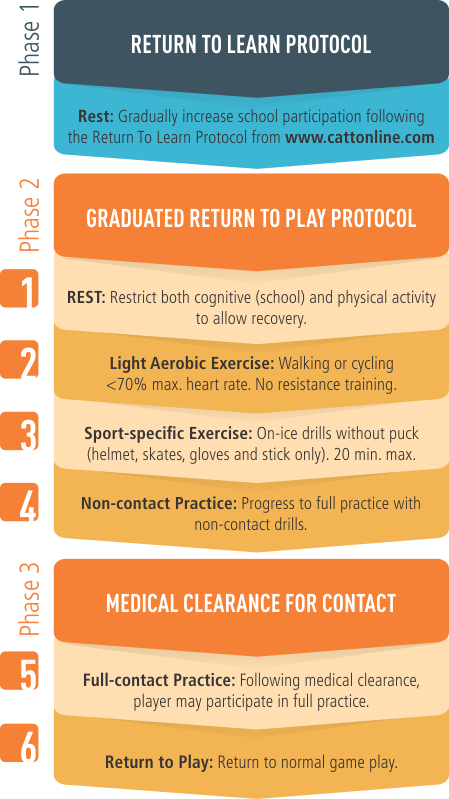Concussions
What is a Concussion?
Concussions are a form of traumatic brain injury induced by biomechanical forces that result in neurological signs and symptoms that typically resolve spontaneously within 1 - 4 weeks of injury.1
Head Injury Recognition2
Although the formal diagnosis of concussion should be made following a medical assessment, all sport stakeholders including athletes, parents, coaches, officials, teachers, trainers, and licensed healthcare professionals are responsible for the recognition and reporting of athletes who demonstrate visual signs of a head injury or who report concussion symptoms. This is particularly important because many sport and recreation venues will not have access to in-site licensed healthcare professionals.
A concussion should be suspected in any athlete who sustains an impact to the head, face, neck, or body, and demonstrated ANY of the visual signs of a suspected concussion of reports ANY symptoms of a suspected concussion as detailed in the Concussion Recognition Tool 5 (CRT-5). A concussion should also be suspected if a player reports ANY concussion symptoms to one of their peers, parents, teachers, or coaches, or if anyone observes an athlete exhibiting any of the visual signs of concussion.
In some cases, an athlete may demonstrate signs or symptoms of a more-severe head or spine injury including convulsions, worsening headaches, vomiting or neck pain. If an athlete demonstrates any of the “Red Flag” indicated by the CRT-5, a more severe head or spine injury should be suspected, and Emergency Medical Assessment should be pursued.
Return to School & Play
Concussion may affect the ability to learn at school. A child may need to miss a few days of school after a concussion, but their physician should help them get back to school after a few days. When returning to school, some students may need to go back gradually and may require certain accommodations to their schedule and environment to ensure their concussion symptoms do not worsen. If a particular activity makes symptoms worse, that activity should be stopped and the student should rest until symptoms improve.
To endure the student can return to school without any problems, it is important that the health care provider, parents, caregivers, and school staff communicate so that everyone knows what the plan is for the student's successful return.
A graduated, step-wise return to physical activity may be implemented following 24-48 hours of complete rest from cognitive and physical activities. The primary concern is getting students back into the classroom before returning to their sport.
We recommended visiting School First for more information.
Concussion Awareness Training Tool (CATT)
The Concussion Awareness Training Tool (CATT) is a series of online educational modules and resources addressing concussion recognition, diagnosis, treatment, and management. Good concussion management may decrease the risk of brain damage and potentially reduce long-term health issues.
Developed by Dr. Shelina Babul, Associate Director/Sports Injury Specialist with the BC Injury Research and Prevention Unit, BC Children’s Hospital, Vancouver, British Columbia, Canada, CATT is based upon the established principles of the Consensus Statement on Concussion in Sport. The 2017 Concussion in Sport Group (CISG) Consensus Statement builds on the principles outlined in previous concussion statements and aims to develop a better understanding of sport-related concussion, their prevention, and their management.
There are eight CATT online educational modules. All online educational modules are available in English and French and free-of-charge.
- CATT for Medical Professionals
- CATT for Coaches
- CATT for Parents
- CATT for School Professionals
- CATT for Athletes
- CATT for Workers & Workplaces
- CATT for Women’s Support Workers
- CATT for Youth
More Information
Concussion recognition and management are complex processes that require a detailed understanding of the guidelines established in the Berlin Consensus Statement.
The Canadian Guideline on Concussion in Sport addresses these 7 areas in the prevention, recognition, diagnosis, and management of sport-related concussion:
- Pre-season education
- Head injury recognition
- Onsite medical assessment
- Medical assessment
- Concussion management
- Multidisciplinary concussion care
- Return to Sport / School
1 McCrory et al. (2017). Consensus statement on concussion in sport - the 5th international conference on concussion in sport held in Berlin, October 2016. British Journal of Sports Medicine; 51(11), 838-847.
2 Parachute (2017). Canadian Guidelines on Concussion in Sport. Toronto: Parachute.
 RED FLAGS
RED FLAGS
If any of the "Red Flags" or observable signs are noted after a direct or indirect blow to the head, the athlete should be immediately and safely removed from participation and evaluated by a physician or licensed healthcare practitioner.
- Neck pain or tenderness
- Double or blurred vision
- Weakness or tingling/burning in arms or legs
- Severe or increasing headache
- Seizure or convulsion
- Loss of consciousness
- Deteriorating conscious state
- Vomiting
- Increasingly restless, agitated, or combative
Last revised on 9 April, 2024.
